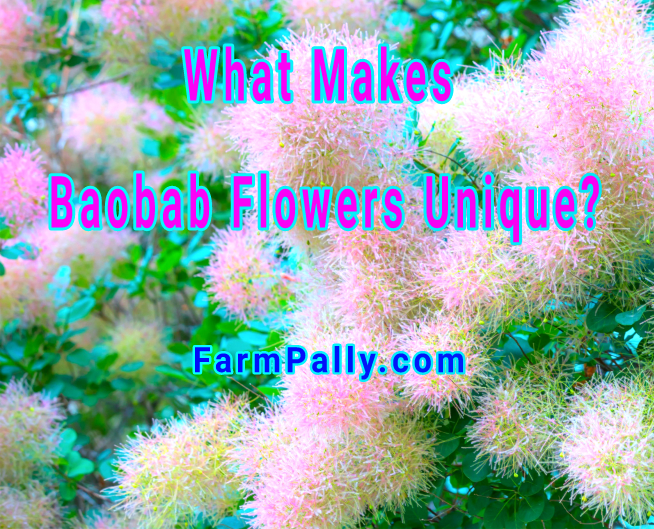Baobab Blossoming, Pollination, Fertilisation, and Fruiting
The Baobab tree, a very popular member of the genus Adansonia, and the Malvaceae family, commonly referred to as the “Tree of Life” is unique and special in many ways.
The baobab flowers in particular are not like other flowers in the plant kingdom.
What makes Baobab unique are the flooring, pollination, fertilization and fruiting which happen in a unique way.
It begins flowering slowly with the buds taking several weeks before they develop, and forms thread-like stalks that dangle from the thick, gnarled branches.
In these buds, the petals, stamens, and ovaries are developed.
Once we’re getting into the winter season, the tree shifts from vegetative to reproductive growth.
The plant tissues transport nutrients to the branches to support the formation of floral meristems.
These meristems form the sepals, petals, stamens, and pistil of the flowers, preparing the tree for pollination, fertilization, and fruiting.
Pollination and Fertilisation
At night, the buds swell, and the petals burst. This creamy-white blossom glows under moonlight.
The broad, silky petals are tinged with ivory or pale yellow, while the stamens cluster at the centre, creating a fuzzy pompom-like design.
During this period, the Baobab scent becomes sour, musky, and decaying, attracting nocturnal animals like fruit bats, hawk moths and Rousettus aegyptiacus.
Surprisingly, by morning, the flowers would start to wilt, turning brown, and fall off throughout the day.
Pollinators drink nectar from the deep floral cup and brush against the pollen-covered stamens, and when they visit another flower, they transfer the pollen onto the stigma of another flower, leading to cross-pollination.
Fertilisation and Fruiting
Fertilization starts with the germination of pollen on the stigma, growing tubes that reach the ovary and fertilize the ovules.
The petals later drop, while the ovary beneath them grows into a large, woody fruit.
Both the baobab flowers and fruits are edible for humans.
Besides eating it, the flowers symbolise fertility, beauty, positivity, strength, longevity, and are used in traditional medicines and rituals.
What makes Baobab Flowers Unique and Special?
It blossoms only at night
While other plants bloom in daylight, especially during midday to attract pollinators like butterflies, the baobab tree blooms only at night.
This ensures only nocturnal animals, mainly bats, can pollinate the baobab flowers.
Baobab flowers bloom and die in 24 hours
It’s rare to find flowers that have such a very short lifespan as the Baobab flowers.
A baobab flower lives for barely 12 to 24 hours before wilting.
It emits a distinct musky scent
Most plant flowers emit a nice scent when flowering but the baobab tree releases a musky, sour odour that smells like decaying fruit or vinegar.
It has a unique floral structure
Baobab flowers have a complex floral structure, with each flower having 5 broad, crinkled petals and a dense tuft of stamens surrounding a long style.
The structure allows bats, the main pollinator, to brush against the stamens as they drink nectar, maximising pollen transfer.
Baobab depends on bats for survival
The baobab trees and fruit bats exhibit a symbiotic relationship.
Bats are nocturnal, and they get food from the nectar of baobab flowers at night while the baobab needs nocturnal animals to pollinate its flowers when it blooms at night.
It symbolizes life and fertility
In many African cultures, the baobab flower symbolizes fertility, renewal, and life.
Its brief blooming during the early rainy season signifies hope, new beginnings, and the promise of abundance.
The blooming of the baobab flowers is seen as a spiritual sign of blessing in many traditional settings.
It is rare and endangered
Baobab species such as Adansonia grandidieri in Madagascar are now endangered due to deforestation and climate change.
The loss of bat populations further threatens their pollination, and survival.
Each bloom is thus a rare and increasingly precious event. It holds cultural and spiritual power
Baobab flowers are linked to ancestral spirits and used in local myths and rituals.
In some cultures, flowering is not merely botanical but mystical.
People don’t disturb blooming trees at night, believing the gods visit the trees during flowering to bring blessings.

Growing up in a family deeply rooted in agriculture, I developed an early passion for cultivating the land, caring for animals, and exploring sustainable ways to improve farm productivity.
I’ve worked extensively across multiple areas of agriculture, food and cash crop cultivation, poultry farming, fish farming etc.
At FarmPally, I enjoy sharing practical insights drawn from real-life experiences to help farmers, pet owners, and agriculture lovers make informed, and sustainable decisions.

